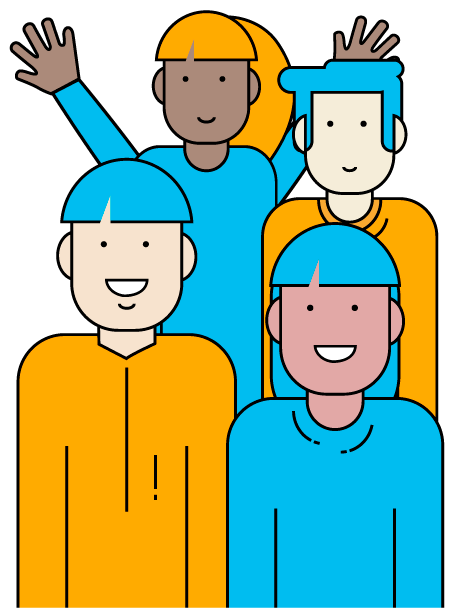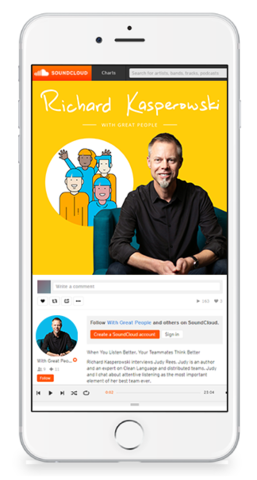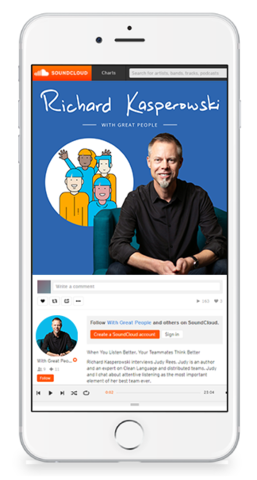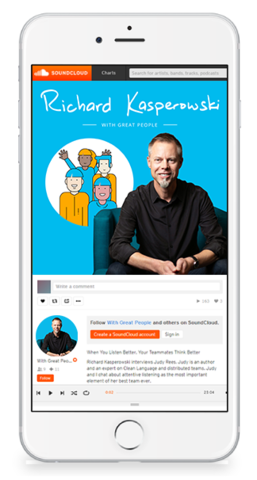There Was This Buzz in the Organization
Johanna Rothman: There Was This Buzz in the Organization
with Johanna Rothman
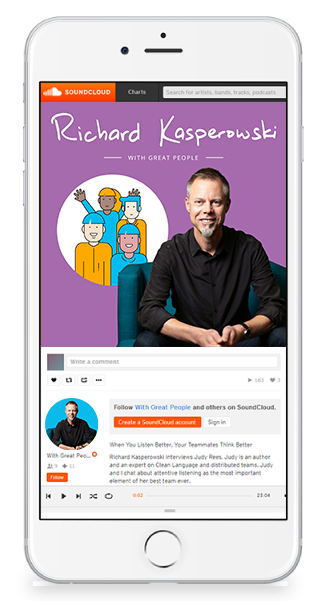
TRANSCRIPT
Richard: 00:11 Hi, friends. Welcome back to With Great People, the podcast for high-performance teams. I’m Richard Kasperowski. This episode is an interview with Johanna Rothman. Johanna is known as the Pragmatic Manager. That’s the name of her email newsletter, where she shares her thinking on practical, pragmatic approaches to hiring people, looking for a job, and managing projects, programs, and portfolios. Johanna talks about her best team ever, and the energy they felt together.
Richard: 00:43 I also want to let you know about IIL’s Agile and Scrum Online Conference 2019. We just did the video shoot for my session at the conference; I’ll be talking about team-building and high-performance teams, and I think you’re going to love it. The conference includes 24 of the most interesting current speakers on agile. For more information and to register, visit the events page of my website at kasperowski.com/events. And remember, to support this podcast, sign up for my newsletter at kasperowski.com. Thanks for listening.
Richard: 01:18 Hi, Johanna. How are you?
Johanna: 01:19 Great, Richard. How are you?
Richard: 01:21 Good, thanks. And we’re here in Johanna’s secret hideout on the outskirts of Boston, Massachusetts. It’s a beautiful day, the breeze is fantastic up here on the hill. I love it.
Johanna: 01:35 I love it also, and you should know that Richard already told me that while cleaning my office was the last thing on my list, it should be the first thing on my list.
Richard: 01:48 I love your office.
Johanna: 01:50 So do I.
Richard: 01:53 All right, will you introduce yourself to our listeners?
Johanna: 01:56 Sure. People know me often as the Pragmatic Manager because that’s the name of my email newsletter, and I provide practical, pragmatic approaches for everything from hiring people, to looking for a job, to managing projects and programs, to managing the project portfolio, to management. If it’s got a P and an M, I probably have some writing about it.
Richard: 02:22 All right. So, this is the podcast about high-performance teams, and what I like to do is ask guests about their best team ever, best team of your life. And so, if you can identify the best team of your life, that’s any group of two or more people aligned with a shared goal, that’s what I say a team is, from your whole life, can you think of the best one of those that you’ve ever been part of?
Johanna: 02:52 So, I have to choose… So, I’m actually thinking of three, and I will choose the middle one. Not the one where I was a lowly engineer, and not the one where I was already a consultant, but the one where I was a program manager, and we had a fairly large program at… This is at Symbolics back in 1988.
Richard: 03:21 Symbolics.
Johanna: 03:21 I know, I know. So, for those of you not around here, Symbolics… And for those of you who are young, Symbolics was a Lisp machine manufacturer back in the ’80s.
Richard: 03:36 Wait, a Lisp machine?
Johanna: 03:36 Lisp machine, I know, I know.
Richard: 03:37 What’s that?
Johanna: 03:38 We thought we were going to compete with Sun, oh… So our marketing was not so good, but the engineering environment was amazing, and it was amazing in several dimensions. We all trusted each other to both do the right thing and do the thing right. So, the nice thing about Lisp is that you’re always… It always runs, right?
Richard: 04:06 Yeah.
Johanna: 04:07 So we were doing small stories, I used to call them “inch-pebbles,” every single day. We would come in to work, and the command was “(load-patches),” so we would load up the previous day’s work since the last time, everything that people had checked in. And so we were running this particular… We were running everything that people had developed.
Johanna: 04:31 Now, did it all work? No, we had problems. But that’s not the point; we trusted each other to fix the problems once we found them. So, we had a lot of trust, we moved fast. We didn’t try to break things, but we discovered that things worked sometimes in ways we did not expect, and we had a great time. I was the program manager for that program from January 1988 until the end of August. Well, I guess the end of… Yeah, the middle of August, because we had a big trade show on August 22nd. And the reason I remember these dates, right, this is 1988, how can you possibly remember dates like that? My daughter was born on August 21st, and the trade show was August 22nd.
Richard: 05:33 Oh.
Johanna: 05:34 So we had a demo-able product, which was a board, the changed operating system, and the operating system that ran on the board, and a few applications.
Richard: 05:46 Oh my God.
Johanna: 05:46 That was MacIvory, yeah. So, I don’t know how much you remember of Symbolics, but it was-
Richard: 05:52 In 1989, my first real tech job was a company called [ICAD 00:05:58] in Kendall Square in Cambridge.
Johanna: 06:00 Yeah?
Richard: 06:02 I had a Symbolics Lisp machine on my desk.
Johanna: 06:06 You had a 3600.
Richard: 06:07 It was so great.
Johanna: 06:08 Yeah.
Richard: 06:10 Looking back at it, before we had the jargon that we use today, we were doing continuous integration every day.
Johanna: 06:17 Absolutely, yeah.
Richard: 06:17 Just because of the way the read-eval-print loop worked, and the way we all shared code together, you could just incrementally add other people’s code as we went, [inaudible 00:06:29] load patches.
Johanna: 06:30 Yeah, yeah. Yeah, so you know.
Richard: 06:32 Yeah, it was continuous integration before we called it that. We did a form of test-driven development, we had great tests, we had a great packaging system, stuff that my company added on to what your company built, yeah. Yeah.
Johanna: 06:47 Yeah. Yeah, so we couldn’t do continuous delivery then, because we were still shipping on tapes, right?
Richard: 06:54 Yeah.
Johanna: 06:54 But we could do everything else. And when I say to people, that was my experience with agile approaches. We used [inaudible 00:07:02] true agile approach. When I managed the program, we had a monthly deliverable, so everybody focused on that monthly deliverable so that we could build what we needed to do to show people progress. And I used rolling-wave planning so that we would have… We had the plan for next week in, the proposed plan for a couple weeks after that, and as we finished a week, I would update the plan, and the plan was always on stickies on the whiteboard, because I didn’t have any project management software. We didn’t need project management software, because we… I mean, first of all, it doesn’t make sense for a program. We had too many teams, we had, you know, 150 people or something working on this program. So everyone took care of their own stuff. We all focused on, what was this goal for this month? Right? We had the program goal, and what was the goal for this month? How could I as a human contribute to this goal? And it really worked out well.
Richard: 08:08 Awesome. I love the story of that team, and I want to see if we can sum it up in one word. Sometimes people do this sort of like a guided meditation. If you… You’ve already taken yourself back to the experience of that team. When you re-experience it, and really re-experience even the physical sensations of being part of that team, is there one word that you could use to describe the sensation of being with that group?
Johanna: 08:43 I think the one word might be “energy.”
Richard: 08:46 Energy.
Johanna: 08:47 Yeah, because I had the trust with people, but we were… There was this buzz in the organization, where you could go to the hardware people and there was a buzz. Yeah, some problems were really hard, and they would kind of complain and whine, but they went back to work. And the mechanical people said, “I really need a bigger footprint,” and I said, “You don’t got one.” Right? So, you know, you don’t get what you want, but you get what you need. And the software people were very excited, so I think that there’s something about energy in that entire experience.
Richard: 09:28 Oh, really? Energy. And you’ve talked about some of the things that you did with that crew; how do you know it was so good? Is there anything else subjective that you could use to gauge that it was the best team ever, or anything objective that you could use to gauge that it was the best team of your life? Are there any metrics, is there… What do you have?
Johanna: 09:54 When people ask me about the best teams I’ve ever been a part of, I think about when I used to run AYE with Jerry and Esther and Don, because we were a cohesive team, and we had Dave Smith and Steve Smith a few years before that, because we understood how to work together. And I think of, also, of the team when I was a young software developer working with a mechanical guy and a hardware guy back at Digilab, and then another team at Automatix.
Johanna: 10:32 And I think that the key for this particular experience at Symbolics is… Why I think it’s the best is because it’s not that everybody had a great time every day, right? You always have ups and downs. But the entire experience was so focused and so goal-oriented, and we were doing something that was really important. So that’s how… I mean, it made a difference in our professional lives, and it made a difference in other people’s professional lives.
Richard: 11:13 Certainly in mine, as one of your customers.
Johanna: 11:15 Yeah. Yeah, because whatever we learned there on MacIvory, we put back into the 3600.
Richard: 11:20 Yeah.
Johanna: 11:21 Yeah, so it was… It ended up being something really, really wonderful.
Richard: 11:28 Yeah.
Johanna: 11:29 Yeah.
Richard: 11:29 All right. Now, what were three or, you know, one, two, three, you pick a number, what were some of the concrete behaviors that people on that team engaged in together that went into that success?
Johanna: 11:46 There were a few things that were technical, right? You’ve talked about continuous integration, so we could always see where we were, right? We had literally continuous integration. People would create something on a Monday afternoon, check it in, ask for code review, and we had… not instantaneous code review, but there were people affiliated in small groups who were able to do code review as we proceeded. So we had the technical excellence circle, so that really worked.
Johanna: 12:28 We also had… How can I say this? Well, I’m just going to say it. We did not have a lot of management, right? So every team did not have a project manager, they didn’t have a coach, they didn’t have a scrum master. I mean, scrum hadn’t… I’m not sure was invented yet. We had a program manager, and we had a few people who corralled, for lack of a better word, several teams to make sure that they had their deliverables, they were all focused in the same direction. So I actually talked to the technical leads for many of those teams on a fairly regular basis, and I said, “Are you with me? Are we going in the same direction? Because if we’re not going in the same direction, we need to fix that right away.”
Richard: 13:23 Yeah.
Johanna: 13:23 Right? “Because we have this milestone coming up, our monthly milestone. We need to make sure we’re headed in the same direction.” “Oh, JR, you don’t understand.” “No, I do understand, and we need to be headed in the right direction.” “Do I have the wrong direction?” is a question I always asked. Right? Because if I had the wrong direction, I would fix that. So I was happy to re-plan, I was happy to rethink, and they were happy to re-plan. So I think the key is that our plans guided us towards this deliverable, but they were not set in stone.
Richard: 14:00 Right, so you weren’t locked into them.
Johanna: 14:02 Yeah.
Richard: 14:02 Which is important if you’re not going in the right direction.
Johanna: 14:05 Yeah. Yeah, yeah. Everyone had this very high focus on technical excellence. I had a high focus on program excellence, which meant I could ask people to move in the same direction. And I didn’t tell anybody what to do. I think that this… Oh, for too long in projects and programs, somebody has been in charge of telling other people what to do, and you know, we hire adults. They can get themselves dressed, they can feed themselves. They have mortgages, they have children. Nobody tells them what to do in any other portion of their lives, so why would we tell them at work? So that was part of the trust, right? Everybody trusted each other to do the best job they could, and they checked on each other with code review.
Richard: 15:01 Okay, yeah.
Johanna: 15:03 Because, you know, we are blind to our own faults. And I trusted each other, everybody on the program to do the best job they could, and to check with me, or to tell me I was wrong, and that was fine too.
Richard: 15:21 Cool. Now, how about advice for listeners? What can… 30 years later from Symbolics and the MacIvory project, which was really, really awesome. And honestly, working with Symbolics Lisp machines way back, 30 years ago, these are some of the defining moments of my career as a techie. It was actually like the beginning of my career. I’m blessed to have been able to work in that kind of environment, where we were doing continuous integration, and good testing, and we have good tooling that other people who weren’t using Lisp machines didn’t have.
Johanna: 16:02 No, they did not have it.
Richard: 16:05 Yeah.
Johanna: 16:05 Yeah.
Richard: 16:06 And kind of lucky, because it took at least a decade, maybe a couple of decades before people had similar tooling to be able to build software that effectively.
Johanna: 16:14 Even just the windowing system and the fact it was a multi-application system, right? You could keep several applications open at the same time.
Richard: 16:24 Yeah.
Johanna: 16:24 That was new back then.
Richard: 16:27 Yeah. Memory management, garbage collection.
Johanna: 16:33 I know, yeah. When I got there, my boss… I went in as a tester, because they told me, quote, I was “too stupid to be a developer,” end of quote. Because I didn’t know Lisp, right? My first Lisp programs look a lot like FORTRAN. But that’s what I do.
Richard: 16:50 I think mine looked like C.
Johanna: 16:51 Yeah, yeah. So my boss asked me to test the scheduler and the garbage collector, so I… I mean, I’m a developer by training. I wrote little tests and asked people to review them, and they said to me, “I never thought of the scheduler like that. I never thought of the garbage collector like that.” Oh, my tests didn’t work, but the fact that I was asking people for feedback, and it was a safe place to ask for feedback, that actually helped. And now I’ve totally forgotten your question. What was the question?
Richard: 17:29 So, back to the question: What advice could you share with listeners for how they could reproduce some of the kind of success that you experienced on that team?
Johanna: 17:37 I think the biggest thing is the courage to be vulnerable.
Richard: 17:45 Okay.
Johanna: 17:46 So, I did not say, “I’m the program manager, I have all the answers.” I didn’t do that, and I think that that made a huge difference in how people perceived me.
Richard: 18:02 What’s the specific behavior that goes along with courage to be vulnerable?
Johanna: 18:07 I put everything out for review. So, I tried to write a little script that would send out specific questions to specific people, and I made a mistake in the script, and I ended up sending blank emails to people, and so I sent out another email that was an apology. I said, “Sorry, my script had [inaudible 00:18:31]. I’m going to fix this.” And Mike McMahon, who was a very famous guy in the Lisp world, said to me… What was his response? It was actually very funny. There was something like, “Insufficient data,” or something like that, in my email to him. So I’m thinking, “Oh…” But you can make mistakes, and it doesn’t kill you.
Richard: 19:02 Yeah.
Johanna: 19:02 Right? People might make fun of you, they might laugh at you for a little bit, but then they don’t… The mistake does not kill you, and it does not define you as a human. I’ve made tremendous mistakes, and I’m still here, right? And I’m not just alive and kicking, I’m thriving. So if I can make mistakes in a job that was big for me at the time, if I can make mistakes at conferences, if I can make mistakes even with clients, I’m still here.
Richard: 19:37 Yeah.
Johanna: 19:37 I mean, what’s the worst thing that can happen? So I think that the courage to be vulnerable makes you human, allows for you to make mistakes, and allows and encourages other people to take that step, so that they might make a mistake also.
Richard: 19:55 All right, this has been a great conversation. I’ve had a lot of fun; you can tell by the smile on my face, you can tell by the smile on your face.
Johanna: 20:00 Yeah. Yeah.
Richard: 20:00 If we had a metric for great conversation, it would be size of smile on number of faces.
Johanna: 20:08 We would have the maximum, yes, the maximum.
Richard: 20:13 Is there anything else you’d like to add, anything else you want to share with listeners? I know you have a new book out.
Johanna: 20:20 So, Create Your Successful Agile Project is out. I’m working on another Distributed Agile Teams book with Mark Kilby, and the management myths… I’m collecting the management myths into three books instead of one humongous book, so those should be out, in quotes, “soon,” as in a first draft, a first iteration will be available on Leanpub… When does this go out? When do you think that this will publish?
Richard: 20:52 Oh, this could be a couple of months, so yeah, it might be out by the time this gets published.
Johanna: 20:56 Oh. Oh, so yeah. Yeah, so those will probably be available, at least on Leanpub, by then.
Richard: 21:03 Okay.
Johanna: 21:03 Yeah.
Richard: 21:04 All right, great.
Johanna: 21:04 Yeah.
Richard: 21:06 And if listeners want to get in touch with you, is there a way for them to do that?
Johanna: 21:09 Absolutely. Everything is on jrothman, J-R-O-T-H-M-A-N, dot com, because I got my URL back when first initial, last name was sufficient. Yeah.
Richard: 21:22 All right. Johanna Rothman, thank you very much for joining us today. It’s been a pleasure.
Johanna: 21:28 Thank you so much. I’ve really enjoyed it.
Richard: 21:31 Hi, friends. Thanks for listening, and remember, to support this podcast, sign up for my newsletter at kasperowski.com.



